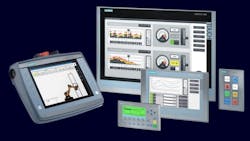Human-machine interfaces (HMIs) facilitate interaction between a human operator and a machine, allowing users to control machinery and receive feedback while ensuring smooth and efficient operation. These interfaces can range from simple physical controls like buttons and switches to advanced digital touchscreens and graphical displays that provide real-time feedback and enable quick adjustments to the manufacturing process.
The complexity of modern machines, powered by programmable logic controllers (PLCs) and sensors to execute repetitive tasks precisely, necessitates robust HMI and remote control.
Opting for a single HMI on a machine reduces costs, lowering hardware and software customization costs while simplifying the control interface. However, this streamlined design can limit efficiency by requiring operators to manage diverse tasks on a single screen.
Designing for multiple HMIs incurs higher upfront costs but provides the advantage of enhanced task specialization, real-time monitoring and streamlined communication. Though the use of multiple HMIs allows for enhanced collaboration among operators and promotes better communication and coordination in complex manufacturing environments, the costs to scale these optimized solutions have led machine designers to use fewer HMIs in the machine design stage.
This is why modern machine design requires a dynamic balance when weighing the use of a single industrial HMI for cost savings against the efficiency gains associated with more HMIs.
Cost-efficient HMIs change the equation
One new design approach involves harnessing the benefits of a single higher-cost HMI with other features complemented by lower-cost HMIs with more specialized functions. In this approach, the high-cost HMI acts as a central hub, consolidating system control and oversight into a single interface. The central unit can manage essential operations, providing operators with a complete system view. The lower-cost HMIs tailored for specific tasks allow operational efficiency without the vastly increased costs associated with multiple HMI designs of the past. Specialized interfaces can be positioned at critical process points, allowing operators to focus on specific functions without the cognitive load of navigating one all-encompassing interface.
This approach strikes a balance between efficiency and cost. The cost of a feature-rich HMI is required to streamline complex operations and facilitate comprehensive control. Integration of lower-cost HMIs optimizes task-specific workflows, enhancing efficiency and responsiveness. This creates a design synergy that allows a harmonized system that maximizes operational effectiveness and minimizes the cost to achieve it.
Open architecture benefits
Choosing open-architecture HMIs during the design process further reduces initial and ongoing machine costs. The term “open-architecture HMI” refers to an HMI that is compatible with various industry-standard hardware and software. Open-architecture HMIs use industry-standard networking and cybersecurity (UMC/UAC), HTTPS encryption, and browser-based interfaces that allow for easy customization while offering features such as multi-touch displays and gesture control that are already familiar to operators from consumer products, making them easy to onboard.
Considering customization is another essential factor. As manufacturing operations are increasingly customized to meet customer demands, the need for adaptable programming environments becomes paramount. To allow for this, engineers must develop software interfaces that allow operators to program and customize parameters to suit specific manufacturing requirements or process changes. The software must have the flexibility crucial to accommodating variations in product designs, production volumes and process intricacies.
This level of flexibility often requires HMI customization. Truly customizable programming environments allow engineers to customize the interface to match the process thoroughly. A proprietary architecture that is difficult or costly to customize reduces agility and drives up costs.
The adaptability of open-architecture HMIs is particularly valuable in industries with expected rapid product changes and short production runs. Operators can quickly respond to changes in production needs, troubleshoot issues effectively and optimize machine settings without requiring extensive technical expertise. This enhances agility and supports continuous improvement initiatives within the manufacturing environment.
For these reasons, designing intuitive interfaces and choosing easily customizable architectures has become a pivotal aspect of machine design.
Designing flexible machines
Employing multiple HMIs ultimately maximizes the efficiency of machine designs. Using open-architecture systems provides broad compatibility, cost-effective customization and scalability. By prioritizing user-friendly interactions and flexibility in programming, engineers empower operators to harness the full potential of machines, facilitating efficiency, adaptability and responsiveness.
Ramey Miller is HMI marketing manager at Siemens.
Leaders relevant to this article:

